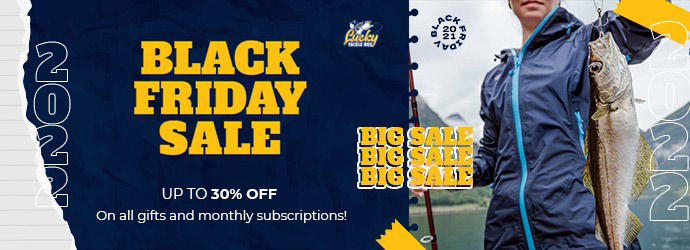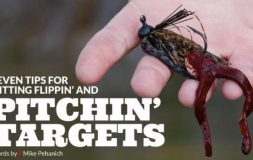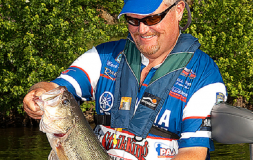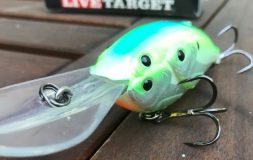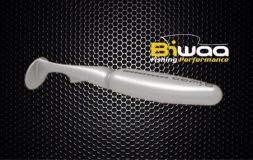Flutter spoons for largemouths
The outing was a lesson in frustration. Pounding typical shoreline structure had produced few largemouth bass, and as the day crept forward, my reliance on this fruitless pattern showcased my fishing shortcomings. “They were here last week,” I muttered to myself, although in slightly more colourful prose.
And so, with my rod firmly tucked between my legs, I began the ride back to the ramp in what can best be described as a drive of shame.
Then it happened. A glance toward the sonar had me do a double take and ease back on the throttle. In the middle of nowhere the screen showed fish – and plenty of them. I fired out a cast, and as the spoon quickly sank through the depths, said a prayer to the big fisherman in the sky. A sweep of the rod lifted the chunk of metal up off bottom while the slack line let it flutter seductively back down. It took four lifts of the spoon before the first fish hit.
Two hours and a dozen or so fish later had me back in good spirits and smiling. It also made me a firm believer in the power of flutter spoons.
The Spoon and the Fork
If spoons are the old time players in the game of fishing, flutter spoons are certainly the new kids on the block. Originally designed and developed to target Lake Forks’ offshore Texas bass, the flutter spoon has become a hot commodity over the last few years. Tournament wins on Fork and other deep-water ledge lakes are to thank for that, and the success of the lure has made manufacturers and anglers take notice.
The reason behind the creation of the flutter spoon is simple. Catching deep largemouth bass can be tough going. Crankbaits can come up short in digging down to the depths and staying there, jigs can struggle to cover water, and few lures on the market can truly replicate the flash of a shad that offshore largemouth bass are known to gorge on.
Design Dynamics
Flutter spoons are similar in style and shape to the trolling spoons used by Great Lake salmon anglers. One big difference is weight. These next generation spoons are heavy, averaging ½ ounce in the four-inch size and 1.3 ounce in the five-inch and larger sizes. Their profile is also bigger in comparison to the more traditional vertical jigging spoons.
Flutter spoons are designed to be worked horizontally, so weight is evenly proportionate throughout the length of the lure. The cupped backside is what produces their namesake action and brass or stainless steel are the two common materials used.
Spooning Where and When
Flutter spoons shine when largemouth bass are down deep and feeding on baitfish.
Mark Rose, an FLW Touring Pro and flutter spoon master offered this insight: “Bottom composition must not contain too much wood. Same goes for vegetation. Look for typical hard-bottomed offshore structure – chunk rock, pea gravel, and clay.”
Most anglers prefer to utilize spoons in water 15-feet and deeper. The majority of my luck has come from 20 to 30-feet down. It all depends on the lake and where the bass take up shop. Don’t be afraid to experiment.
Ledges, humps, points, and breaklines are all prime real estate for largemouth bass. “Many times you’ll see fish all over the lower portion of your sonar screen. You’ll also come across those suspended up in the water column. When they are spread out like this, you’ve stumbled across a perfect spooning scenario,” added Rose. Spooning over soft bottoms is also a productive tactic. Stirring up mud or silt can help catch a bass’ attention and start a feeding frenzy.
Flutter spoons make a great year-round lure. Much of your success will rely on whether your lake supports offshore largemouth bass, no matter what the season. Most always do. Adequate structure and baitfish movement are two key ingredients to be cognizant of. Schools of baitfish constantly move and migrate throughout a lake, so locating them will often put you on top of the bass. When the water cools and bass make a shift to deeper wintering holes, flutter spoons definitely can outshine other lures.
Spoon-Feeding Subtleties
The weight of flutter spoons allows them to be cast long distances, meaning the angler can keep off of key structure points and cover more water. It also goes without saying that the less interaction your boat has with a school of fish, the greater your odds are for catching them. “Stay back off of your chosen location or school and fire out a cast. Let the spoon sink to the bottom. Once there you want to make a long, steady pull (not rip) with your rod, much like you would work a worm along bottom, only faster. Now let the spoon flutter downwards on a slack line and repeat,” said Rose.
Here is the tactic broken down further. Point your rod tip at the spoon while it rests on bottom and make a sweeping pull while lifting to the 12 o’clock position. Do this in one fluid motion. Now point your rod back down at the spoon, and while reeling up some of the line, maintain a controlled drop while letting the spoon free-fall on slack line.
Allowing the spoon to drop naturally gives it a seductive flutter – a motion that bass can’t seem to resist. “They are reacting to the flash and pulse from the flutter on the slack line. It is imperative you let the spoon fall unimpeded,” added Rose. Mark Pack, owner and president of Lake Fork Trophy Lures and FLW competitor, offered this advice: “Most strikes will come as the lure falls. Bass will often slap at it in an effort to kill the spoon rather than eat it, which can result in a short strike. Keep the lure in the zone and they will often hit it again.”
Color doesn’t seem to be as much as an issue with flutter spoons but recognize that matching your lure to the resident forage will help put the odds in your favour. “I like to choose a spoon with some chartreuse on it when fishing cloudy days or when water is slightly stained. As for clear water, you can’t go wrong with a plain chrome bait for ultimate flash and shine,” added Pack. Depending upon the spoon, line twist can often be a problem. Use a small swivel to free yourself from this frustrating dilemma.
Playing the Fish
Strikes come in a variety of ways, from a bone-jarring smash to a slight bump in the line. Some won’t be felt until you make the next sweep of the rod. Since most bass hit a spoon on the fall, line watching and preparedness are crucial considerations. “Always keep this in mind. Your long casts will result in line stretch. Add to that a heavy lure. Getting a good hookset is paramount. Don’t be shy and really give it to the bass on that initial strike,” suggests Rose. Once a fish is hooked, maintain steady pressure and work them quickly to the boat. Any slack line will give the fish a chance to throw the hook.
Equipment Considerations
To achieve long casts, make effective sweeps, and set the hooks with plenty of gusto, a long rod gets the nod for flutter spoon work. Most anglers are relying on medium-heavy flipping sticks in the 7 ½-foot length. Some are even choosing rods upwards of eight-feet. Experiment to see which you feel most comfortable with.
Both Pack and Rose suggest 15 or 20-pound test fluorocarbon line. The no-stretch component will aid in hooking more fish. A high-speed reel is also recommended, as this will help quickly reign in the slack on the initial hookset.
Flutter spoons are relatively new on the scene but are already making a profound splash. Many anglers can neglect offshore largemouth bass, but when conditions are favourable, they often provide the most consistent action. Flutter some metal in front of the fish this season – you just may become a convert yourself.
If you like what you see, it’s time for a new fishing subscription box. Check out the offer and make sure you find your best pick today!



